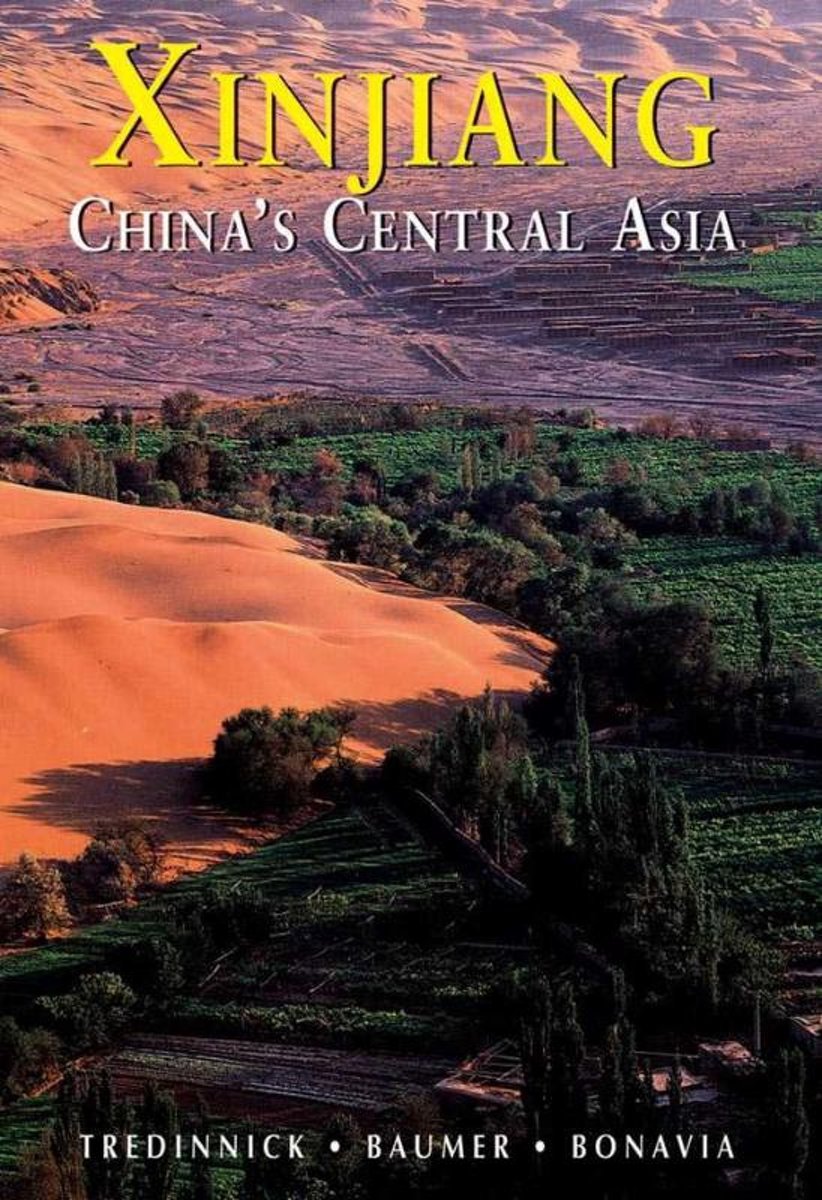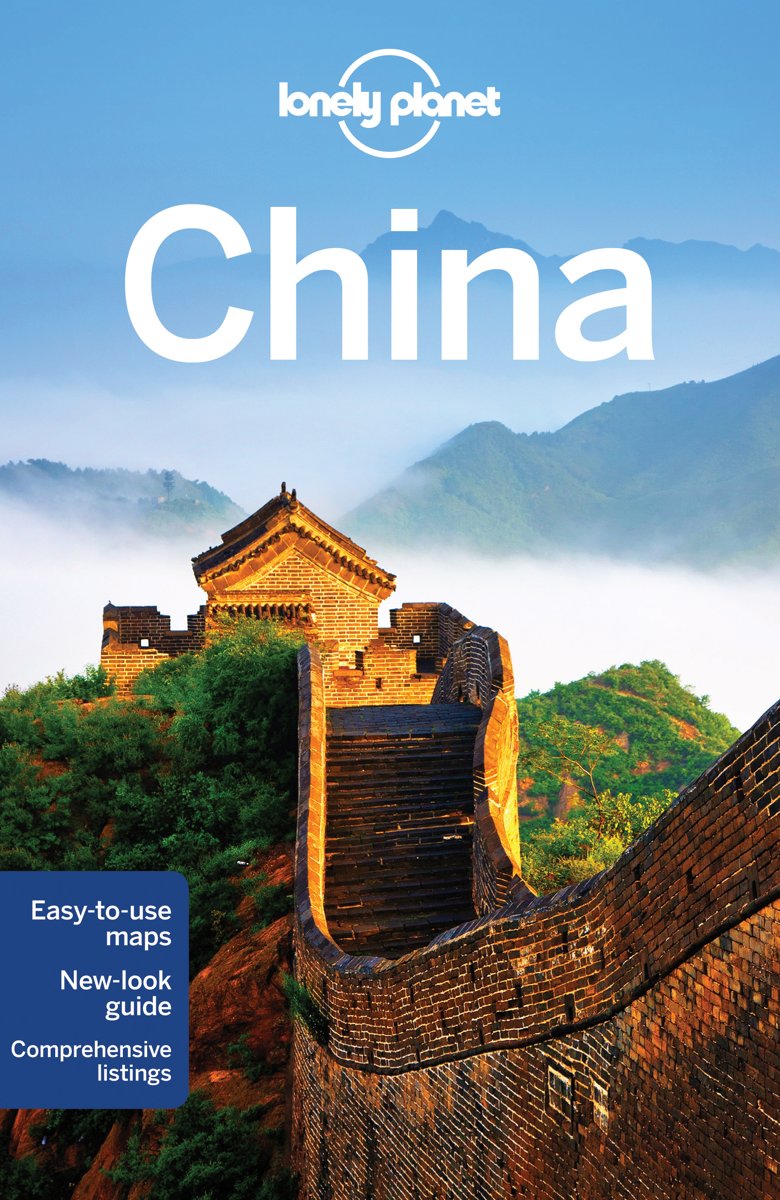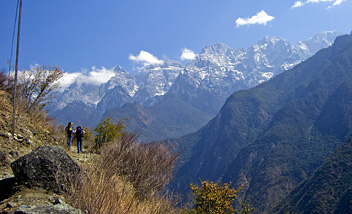Chine
Description
To say China is vast and varied in all respects, is nothing less than an understatement. Climate varies from continental to temperate to subtropical. Landscapes range from relatively low plains and ranges in the east and southeast, to high mountains and plateaus as you move west, culminating in the Tibetan Himalaya and the world's highest: Mount Everest (8848 m). Further to the north and northwest you will encounter merciless deserts like the Gobi and Taklamakan, and more high mountain ranges such as the remote Kunlun, Tianshan and Pamir.
Mighty rivers like the Yangtze (Chang Jiang) and Yellow River (Huang He) flow down from the west through ever more populated areas to find their way into the East and South China Seas. Other famous rivers such as the Mekong (known in China as Lancang), the Brahmaputra and the Indus rivers originate on the Tibetan plateau, and eventually flow south towards the Bay of Bengal and the Indian Ocean. Without exception these rivers have helped create spectacular mountain landscapes, gorges and isolated valleys, making for wonderful hiking and exploring.
Is hiking a popular Chinese passtime? Long distance hiking as such may not be, but pilgrimages up the so-called Sacred Mountains, be it Taoist or Buddhist, definitely are a Chinese favorite. Countless Chinese, old and young alike, are seen scrambling up the slopes of mountains such as Emeishan, Taishan and Huashan. The same goes for mountains famed as inspiration for poets and painters, such as Huangshan. Hiking famous Chinese mountains often means climbing seemingly endless flights of stairs. Be prepared to share the paths with many, many others, and if lucky you are rewarded with breathtaking views.
A challenge popular with foreigners is hiking the Great Wall, usually as a 1- to 7-day hike along more or less intact Great Wall sections near Beijing. Others go for what is considered full length, all the way from Jiayuguan in the west to Laolongtou, the Old Dragon's Head sticking out into the Yellow Sea in the east near Shanhaiguan pass. Completing this full length hike will take you many months, covering a distance of at least 4000 km. With no real provisions for hikers along the way, it requires serious planning and preparation. Not nearly as popular, but a nonetheless interesting venture is retracing the legendary Long March by Mao Zedong and his Red Army. We have included the Great Wall and the Long March under Trails.
Several regions deserve special mention for hiking: the reasonably accessible mountains and valleys of Sichuan and Yunnan provinces, and likewise the minority areas of Guizhou and Guangxi provinces. For the more tough and adventurous: the remote Kunlun and Muztag Ata mountains of Xinjiang province near Kashgar and Kalakuli lake, the Pamir (Congling) mountains in the west of Xinjiang on the border with Kyrgyzstan and Tajikistan, the Tianshan (Heavenly) mountains in the northwest of Xinjiang province, and last but not least: Tibet with it's most famous hike and pilgrimage trail around Mount Kailash, and so much more...
Sentiers
Régions
Montagnes
Liens
Données
Rapports
Guides et cartes
Hébergement
Organisations
Voyagistes
GPS
Autre
Livres

United Kingdom
2014
- Walking Home From Mongolia
- Ten Million Steps Through China, From the Gobi Desert to the South China Sea Lire la suite
- Also available from:
- De Zwerver, Netherlands

Netherlands
2014
- Reisverhaal Walking Home From Mongolia | Hodder & Stoughton
- Ten Million Steps Through China, from the Gobi Desert to the South China Sea Lire la suite

Netherlands
- Yan Wang Preston
- My friend, the tree: a photographic exploration in China, with sometimes harrowing results. In 2013, during a long-term photography project along the Yangtze river, Yan Wang Preston made an incisive observation: In the small village of Xialiu stood an over three-hundred-year-old tree in all of its glory, right in the center of a community that... Lire la suite
- Also available from:
- Bol.com, Belgium

Belgium
- Yan Wang Preston
- My friend, the tree: a photographic exploration in China, with sometimes harrowing results. In 2013, during a long-term photography project along the Yangtze river, Yan Wang Preston made an incisive observation: In the small village of Xialiu stood an over three-hundred-year-old tree in all of its glory, right in the center of a community that... Lire la suite

Netherlands
2012
- Xinjiang
- The enormous area now known as China's Xinjiang Province came to prominence with the rise of the Silk Road two millennia ago. For centuries its nomadic peoples and city-states were subject to both religious and economic influences from India, Greece, Persia and of course China, resulting in a land rich with archaeological and cultural... Lire la suite
- Also available from:
- Bol.com, Belgium
- De Zwerver, Netherlands

Belgium
2012
- Xinjiang
- The enormous area now known as China's Xinjiang Province came to prominence with the rise of the Silk Road two millennia ago. For centuries its nomadic peoples and city-states were subject to both religious and economic influences from India, Greece, Persia and of course China, resulting in a land rich with archaeological and cultural... Lire la suite

Netherlands
2012
- Reisgids Xinjiang | Odyssey
- Een rijk geïllustreerde gids over het noordwestelijke deel van China. Veel nadruk op de geschiedenis en bezienswaardigheden, maar ook een hoofdstuk over bijvoorbeeld het nut van paarden in die omgeving of het raadsel van het wandelende meer. A brand-new cultural and historical guide to China's westernmost region that explores both well-traveled... Lire la suite

Netherlands
- Killing for profit
- Rhino horn is worth more than cocaine, heroin or even gold on the black markets of Southeast Asia and China. Now, Killing for Profit brings you the story of one man s journey into a violent underworld where ruthless criminal syndicates will stop at nothing to attain their prize a tale of greed and corruption and of an increasingly desperate... Lire la suite
- Also available from:
- Bol.com, Belgium

Belgium
- Killing for profit
- Rhino horn is worth more than cocaine, heroin or even gold on the black markets of Southeast Asia and China. Now, Killing for Profit brings you the story of one man s journey into a violent underworld where ruthless criminal syndicates will stop at nothing to attain their prize a tale of greed and corruption and of an increasingly desperate... Lire la suite

Netherlands
- Walking Along with You in America
- Walking along with you in America Beginning at 1980s, many Chinese young students came to the United States with different dreams and hopes. They were far away from their homes, families and friends, struggled for surviving and development in a foreign country. In China, going aboard was like a big wave in the ocean. She, Chen Shuang, a newly... Lire la suite
- Also available from:
- Bol.com, Belgium

Belgium
- Walking Along with You in America
- Walking along with you in America Beginning at 1980s, many Chinese young students came to the United States with different dreams and hopes. They were far away from their homes, families and friends, struggled for surviving and development in a foreign country. In China, going aboard was like a big wave in the ocean. She, Chen Shuang, a newly... Lire la suite

Netherlands
- Beijing & Shanghai
- DK Eyewitness Travel Guide: Beijing and Shanghai is your in-depth guide to the very best of these two metropolitan cities.Take in the major sights, from the breathtaking Great Wall of China to the imperial splendor of the Forbidden City; go on a canal cruise for your chance to contrast the old and new sides of Shanghai; or simply wander the... Lire la suite
- Also available from:
- Bol.com, Belgium

Belgium
- Beijing & Shanghai
- DK Eyewitness Travel Guide: Beijing and Shanghai is your in-depth guide to the very best of these two metropolitan cities.Take in the major sights, from the breathtaking Great Wall of China to the imperial splendor of the Forbidden City; go on a canal cruise for your chance to contrast the old and new sides of Shanghai; or simply wander the... Lire la suite

Netherlands
- Die Ich-Identitat Chinesischer Frauen Seit Der Reformperiode in Partnerschaft, Liebe Und Sexualitat
- Magisterarbeit aus dem Jahr 2012 im Fachbereich Orientalistik / Sinologie - Chinesisch / China, Note: 1,7, Johann Wolfgang Goethe-Universitat Frankfurt am Main (Institut fur Orientalische und Ostasiatische Philologien), Sprache: Deutsch, Abstract: Die Volksrepublik China befindet sich seit 1978 in einem tiefgreifenden Modernisierungs- und... Lire la suite
- Also available from:
- Bol.com, Belgium

Belgium
- Die Ich-Identitat Chinesischer Frauen Seit Der Reformperiode in Partnerschaft, Liebe Und Sexualitat
- Magisterarbeit aus dem Jahr 2012 im Fachbereich Orientalistik / Sinologie - Chinesisch / China, Note: 1,7, Johann Wolfgang Goethe-Universitat Frankfurt am Main (Institut fur Orientalische und Ostasiatische Philologien), Sprache: Deutsch, Abstract: Die Volksrepublik China befindet sich seit 1978 in einem tiefgreifenden Modernisierungs- und... Lire la suite

Netherlands
- The Lost Camels Of Tartary
- This narrative reveals the author's experiences on three expeditions to the Mongolian and Chinese Gobi Deserts, in search of the mysterious wild Bactrian camel. They include a 30-day walk in the Kum Tagh sand dunes and his experience as the first foreigner to cross the Gashun Gobi from north to south. Lire la suite
- Also available from:
- Bol.com, Belgium

Belgium
- The Lost Camels Of Tartary
- This narrative reveals the author's experiences on three expeditions to the Mongolian and Chinese Gobi Deserts, in search of the mysterious wild Bactrian camel. They include a 30-day walk in the Kum Tagh sand dunes and his experience as the first foreigner to cross the Gashun Gobi from north to south. Lire la suite

Netherlands
- A Learning Curve
- Do you enjoy reading about myths and legends, ancient cities, Asian culture and cuisine? A Learning Curve takes readers on an interesting series of adventures through Southeast Asia. With a carefully selected amalgam of different stories from the author's own amusing expeditions to tales of ancient history, famous travellers, and legends that... Lire la suite
- Also available from:
- Bol.com, Belgium

Belgium
- A Learning Curve
- Do you enjoy reading about myths and legends, ancient cities, Asian culture and cuisine? A Learning Curve takes readers on an interesting series of adventures through Southeast Asia. With a carefully selected amalgam of different stories from the author's own amusing expeditions to tales of ancient history, famous travellers, and legends that... Lire la suite

Netherlands
- Wildlife Wonders of China
- China is a country rich in bio-diversity that boasts gorgeous natural landscapes and wildlife, many unique to its land. Award winning nature photographer Xi Zhinong spent 30 years taking photos along rivers and across mountains, capturing the animals and natural wonders of China. Through his lens, a Yunnan snub-nosed monkey can be seen jumping... Lire la suite
- Also available from:
- Bol.com, Belgium

Belgium
- Wildlife Wonders of China
- China is a country rich in bio-diversity that boasts gorgeous natural landscapes and wildlife, many unique to its land. Award winning nature photographer Xi Zhinong spent 30 years taking photos along rivers and across mountains, capturing the animals and natural wonders of China. Through his lens, a Yunnan snub-nosed monkey can be seen jumping... Lire la suite

Netherlands
2000
- Merian live! 12 - Hongkong
- Hongkong werd door koningin Victoria's minister van buitenlandse zaken afgedaan als 'kaal eiland'. Tegenwoordig is deze wereldstad de ontmoetingsplaats van oost en west. Hongkong leeft van haar haven, die zowel de sfeer als de economie bepaalt. Niet alleen Hongkong, maar heel Zuid-China wordt door deze haven verbonden met - en om historische... Lire la suite
- Also available from:
- Bol.com, Belgium

Belgium
2000
- Merian live! 12 - Hongkong
- Hongkong werd door koningin Victoria's minister van buitenlandse zaken afgedaan als 'kaal eiland'. Tegenwoordig is deze wereldstad de ontmoetingsplaats van oost en west. Hongkong leeft van haar haven, die zowel de sfeer als de economie bepaalt. Niet alleen Hongkong, maar heel Zuid-China wordt door deze haven verbonden met - en om historische... Lire la suite

Netherlands
- Finding Mojo
- What does it take to finally let go of things that just aren t working in your life? The suffering of a broken heart? Losing a job? Or maybe the painful disintegration of a long-standing friendship?It is the cruel fusion of all these things and more that leads Natalie to believe the life she s living belongs to somebody else. On discovering... Lire la suite
- Also available from:
- Bol.com, Belgium

Belgium
- Finding Mojo
- What does it take to finally let go of things that just aren t working in your life? The suffering of a broken heart? Losing a job? Or maybe the painful disintegration of a long-standing friendship?It is the cruel fusion of all these things and more that leads Natalie to believe the life she s living belongs to somebody else. On discovering... Lire la suite

Netherlands
2015
- Lonely Planet China
- 14th editionLonely Planet: The world's leading travel guide publisherLonely Planet China is your passport to all the most relevant and up-to-date advice on what to see, what to skip, and what hidden discoveries await you. Get lost in the dynastic grandeur of Beijing's Forbidden City, hike along the Great Wall, or take in Shanghai's neon lights... Lire la suite
- Also available from:
- Bol.com, Belgium

Belgium
2015
- Lonely Planet China
- 14th editionLonely Planet: The world's leading travel guide publisherLonely Planet China is your passport to all the most relevant and up-to-date advice on what to see, what to skip, and what hidden discoveries await you. Get lost in the dynastic grandeur of Beijing's Forbidden City, hike along the Great Wall, or take in Shanghai's neon lights... Lire la suite
Cartes

United Kingdom
- Admiralty Routeing Chart 5149(4) - South China Sea - April
- Essential for use in passage planning for ocean voyages, Routeing Charts include routes and distances between major ports, ocean currents, ice limits, load lines and wind roses. They also contain expected meteorological and oceanographic conditions for each month of the year.Individual chart scales of 1:5,000,000, 1:10,000,000 and 1:20,000,000... Lire la suite

United Kingdom
- Admiralty Routeing Chart 5149(12) - South China Sea - December
- Essential for use in passage planning for ocean voyages, Routeing Charts include routes and distances between major ports, ocean currents, ice limits, load lines and wind roses. They also contain expected meteorological and oceanographic conditions for each month of the year.Individual chart scales of 1:5,000,000, 1:10,000,000 and 1:20,000,000... Lire la suite

United Kingdom
- Admiralty Routeing Chart 5150(8) - East China Sea - August
- Essential for use in passage planning for ocean voyages, Routeing Charts include routes and distances between major ports, ocean currents, ice limits, load lines and wind roses. They also contain expected meteorological and oceanographic conditions for each month of the year.Individual chart scales of 1:5,000,000, 1:10,000,000 and 1:20,000,000... Lire la suite

United Kingdom
- Admiralty Routeing Chart 5149(5) - South China Sea - May
- Essential for use in passage planning for ocean voyages, Routeing Charts include routes and distances between major ports, ocean currents, ice limits, load lines and wind roses. They also contain expected meteorological and oceanographic conditions for each month of the year.Individual chart scales of 1:5,000,000, 1:10,000,000 and 1:20,000,000... Lire la suite

United Kingdom
- Admiralty Routeing Chart 5150(1) - East China Sea - January
- Essential for use in passage planning for ocean voyages, Routeing Charts include routes and distances between major ports, ocean currents, ice limits, load lines and wind roses. They also contain expected meteorological and oceanographic conditions for each month of the year.Individual chart scales of 1:5,000,000, 1:10,000,000 and 1:20,000,000... Lire la suite

United Kingdom
- Admiralty Routeing Chart 5150(9) - East China Sea - September
- Essential for use in passage planning for ocean voyages, Routeing Charts include routes and distances between major ports, ocean currents, ice limits, load lines and wind roses. They also contain expected meteorological and oceanographic conditions for each month of the year.Individual chart scales of 1:5,000,000, 1:10,000,000 and 1:20,000,000... Lire la suite

United Kingdom
- Admiralty Routeing Chart 5149(6) - South China Sea - June
- Essential for use in passage planning for ocean voyages, Routeing Charts include routes and distances between major ports, ocean currents, ice limits, load lines and wind roses. They also contain expected meteorological and oceanographic conditions for each month of the year.Individual chart scales of 1:5,000,000, 1:10,000,000 and 1:20,000,000... Lire la suite

United Kingdom
- Admiralty Routeing Chart 5150(2) - East China Sea - February
- Essential for use in passage planning for ocean voyages, Routeing Charts include routes and distances between major ports, ocean currents, ice limits, load lines and wind roses. They also contain expected meteorological and oceanographic conditions for each month of the year.Individual chart scales of 1:5,000,000, 1:10,000,000 and 1:20,000,000... Lire la suite

United Kingdom
- Admiralty Routeing Chart 5150(10) - East China Sea - October
- Essential for use in passage planning for ocean voyages, Routeing Charts include routes and distances between major ports, ocean currents, ice limits, load lines and wind roses. They also contain expected meteorological and oceanographic conditions for each month of the year.Individual chart scales of 1:5,000,000, 1:10,000,000 and 1:20,000,000... Lire la suite

United Kingdom
- Admiralty Routeing Chart 5149(7) - South China Sea - July
- Essential for use in passage planning for ocean voyages, Routeing Charts include routes and distances between major ports, ocean currents, ice limits, load lines and wind roses. They also contain expected meteorological and oceanographic conditions for each month of the year.Individual chart scales of 1:5,000,000, 1:10,000,000 and 1:20,000,000... Lire la suite

United Kingdom
- Admiralty Routeing Chart 5150(3) - East China Sea - March
- Essential for use in passage planning for ocean voyages, Routeing Charts include routes and distances between major ports, ocean currents, ice limits, load lines and wind roses. They also contain expected meteorological and oceanographic conditions for each month of the year.Individual chart scales of 1:5,000,000, 1:10,000,000 and 1:20,000,000... Lire la suite

United Kingdom
- Admiralty Routeing Chart 5150(11) - East China Sea - November
- Essential for use in passage planning for ocean voyages, Routeing Charts include routes and distances between major ports, ocean currents, ice limits, load lines and wind roses. They also contain expected meteorological and oceanographic conditions for each month of the year.Individual chart scales of 1:5,000,000, 1:10,000,000 and 1:20,000,000... Lire la suite

United Kingdom
- Mount Gongga Glaciers
- Mount Gongga Glaciers on a detailed, contoured map at 1:25,000 published by the Chinese Institute of Glaciology and based on surveys carries out in early 1980s and aerial photography from December 1996. The map has contours at 20m intervals, enhanced by shading, plus graphics and/or colouring for exposed rock, scree, moraine, crevasses,... Lire la suite

United Kingdom
- China West ITMB
- Western China on a double-sided, indexed road map from ITMB at 1:3,000,000, with three insets providing a street plan of central Lhasa, a wider coverage of the city and a plan of the Norbulingka complex. The map divides the region north/south and coverage extends east to approx. 106° (Lanzhou/Chengou).The map has altitude colouring in feet,... Lire la suite

United Kingdom
- Admiralty Routeing Chart 5149(8) - South China Sea - August
- Essential for use in passage planning for ocean voyages, Routeing Charts include routes and distances between major ports, ocean currents, ice limits, load lines and wind roses. They also contain expected meteorological and oceanographic conditions for each month of the year.Individual chart scales of 1:5,000,000, 1:10,000,000 and 1:20,000,000... Lire la suite




